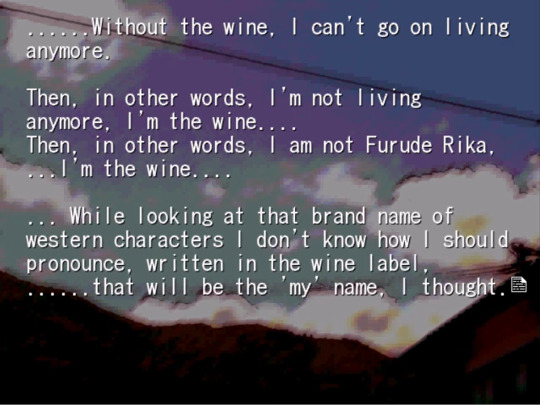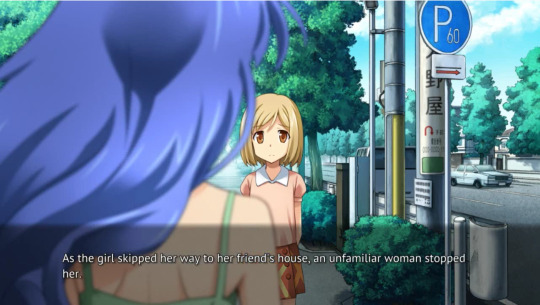#it's a minor miracle bern has a halfway reasonable name
Text
Witches and Fragments in Original Higurashi
<< Introduction

If we want to talk about witches, we actually need to start with Higurashi proper. Bernkastel and the Sea of Fragments are introduced in the original Higurashi visual novel, but they were almost entirely left out of the anime. This section covers anything anime-only viewers may be missing.
Reading List: Highlights
Matsuribayashi Secret Ending [ Video ]
Bernkastel grants young Miyoko a miracle in advance.
Bernkastel-Birth and Poems [ Video ]
A roughly six minute compilation of the Bernkastel references in Saikoroshi plus all of her Higurashi poems.
Reading List: I want it all
Minagoroshi-hen / Massacre Chapter
Matsuribayashi-hen / Festival Accompaniment Chapter
Saikoroshi-hen / Dice Killing Chapter
Wiki pages
https://07th-expansion.fandom.com/wiki/Sea_of_Fragments
https://07th-expansion.fandom.com/wiki/Frederica_Bernkastel/Character

The Sea of Fragments
-In the prologue to Minagoroshi, it is revealed that all of the previous arcs are "Fragments" (aka “shards” or "カケラ / kakera") - separate, parallel worlds that appear as crystals floating in an abstract void.
-The general term for this void space is the "Sea of Fragments."
-In Higurashi, the only characters who usually exist in this space are Rika(s) and Hanyuu. The Minagoroshi prologue confusingly implies there are many Rikas in this space, but this gets retconned by how it is depicted in Umineko. (I’ve heard the Higurashi manga matches the Umineko depiction.)
-The start of Gou Episode 2 takes place in the Sea of Fragments, as does part of Episode 14 and the last part of Episode 20.
-Gou is the first time the Sea has had the Furude Shrine floating in the background. Or any ground to stand on, for that matter.
-The Sea does not contain just Higurashi timelines; presumably it contains infinite variations of infinite worlds.
-In both Umineko and Gou Episode 14, characters leave to explore further reaches of the Sea. In particular, Bern and Lambda’s games are created out of sections of the Sea, either a single Fragment as seen in “The First and Last Gift” or many related Fragments as in Higurashi and Umineko.

Frederica Bernkastel in Higurashi
-First "introduced" as the attributed author of the poems that preface each Higurashi arc.
-There is a (very old) character guide that includes “Message from Frederica Bernkastel” where Frederica teasingly denies being Rika. See this Reddit discussion for more context.
-However, in Minagoroshi, we see Rika recite one of "Bernkastel's" poems, as well as Rika making several references to thinking/acting like a "hundred year old witch."
-The Saikoroshi arc explores this contradiction in detail:
While being trapped in a dream of a perfect Fragment, Rika begins to consider her mature personality - essentially her memories of other worlds - as a separate being from the “Furude Rika” she replaced in this Fragment. She names her current, looping-aware persona "Frederica Bernkastel".
After Rika reawakens in the Matsuribayashi Fragment, she resolves to abandon thinking like “Frederica Bernkastel” and live fully as the “Furude Rika” who only has this one world. However, she speculates that her other persona might still live on in a higher plane of existence.
At the end of Saikoroshi, Hanyuu ambiguously mentions making a new friend. It’s possible to read this as implying that “Rika” and “Bernkastel” have fully split their consciousnesses.

-Because of that “higher dimension” idea, most people use "Frederica Bernkastel" to refer to the Rika that appears in the Sea of Fragments, i.e the narrator at the beginning of Minagoroshi who names each arc.
-This same narrator also talks to the reader/Hanyuu during the Connecting Fragments puzzle in Matsuribayashi, even going as far as to describe Hinamizawa and the characters within as a game board and pieces.
-She also appears in the secret ending to Matsuribayashi, where she enters a Fragment as a mysterious adult woman who sets young Miyoko on a path to a life where her parents don't die.

Lambdadelta
Neither Lambdadelta nor Featherine appear by name in Higurashi.
With Lambda, in hindsight, you could perhaps argue that some scenes in Takano's backstory (where she references wishes and the power to write fate) might be alluding to and/or influenced by her. However, in interviews, Ryukishi07 has poked fun at the idea of Lambda existing in Higurashi. For example:
“I admit there's a character named Bernkastel in Higurashi, but I don't remember there being a character named Lambdadelta. Why does anyone think [Lambda] has appeared in Higurashi? When human beings encounter an unknown thing, they would automatically regard it as something that exists in their memory. Those who've played Higurashi might have directly fallen into a trap.”
(Source: Interview with Ryukishi07 (2009))

Featherine
With Featherine, the absence is complete (before Gou) - while Hanyuu and Featherine share some similarities, even Hanyuu’s adult form from the past had no direct connection with witches. (At least as far as I’m aware - people familiar with the console arcs or Kamikashimashi, feel free to correct this!)
However, those similarities are vague but intriguing. Most notably, in Saikoroshi, Hanyuu says that the “her” of the dream Fragment ascended after being satisfied with how the human world. It is then implied that she may have done the same herself at the end of the arc, allowing Rika to live a normal life. (Another case I’ve heard is more explicit in the manga.)
In addition to likely being the explanation for Hanyuu’s disappearance in Gou, this ascension is something referenced in Featherine’s backstory as well...
Next (Witches and Fragments in Umineko) >>
#when they cry#higurashi#higurashi gou#umineko#bernkastel#furude rika#furude hanyuu#my ramblings#higurashi guide to witches#you know#given how drunk rika is in that saikoroshi scene#it's a minor miracle bern has a halfway reasonable name#unlike a certain *other* witch...
35 notes
·
View notes